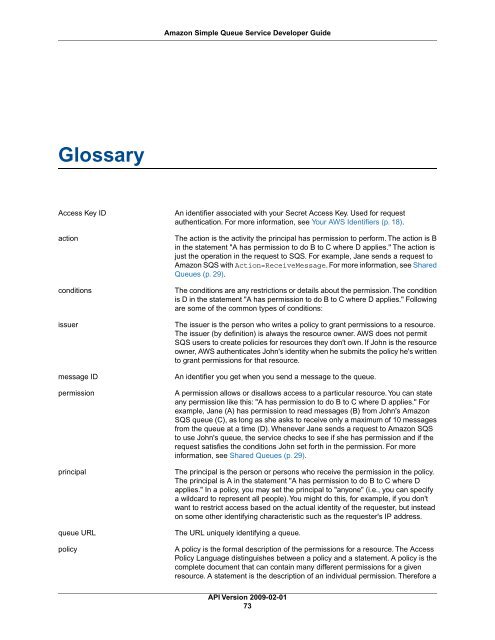sqs-dg-2009-02-01
Create successful ePaper yourself
Turn your PDF publications into a flip-book with our unique Google optimized e-Paper software.
Amazon Simple Queue Service Developer Guide<br />
Glossary<br />
Access Key ID<br />
action<br />
conditions<br />
issuer<br />
message ID<br />
permission<br />
principal<br />
queue URL<br />
policy<br />
An identifier associated with your Secret Access Key. Used for request<br />
authentication. For more information, see Your AWS Identifiers (p. 18).<br />
The action is the activity the principal has permission to perform. The action is B<br />
in the statement "A has permission to do B to C where D applies." The action is<br />
just the operation in the request to SQS. For example, Jane sends a request to<br />
Amazon SQS with Action=ReceiveMessage. For more information, see Shared<br />
Queues (p. 29).<br />
The conditions are any restrictions or details about the permission. The condition<br />
is D in the statement "A has permission to do B to C where D applies." Following<br />
are some of the common types of conditions:<br />
The issuer is the person who writes a policy to grant permissions to a resource.<br />
The issuer (by definition) is always the resource owner. AWS does not permit<br />
SQS users to create policies for resources they don't own. If John is the resource<br />
owner, AWS authenticates John's identity when he submits the policy he's written<br />
to grant permissions for that resource.<br />
An identifier you get when you send a message to the queue.<br />
A permission allows or disallows access to a particular resource. You can state<br />
any permission like this: "A has permission to do B to C where D applies." For<br />
example, Jane (A) has permission to read messages (B) from John's Amazon<br />
SQS queue (C), as long as she asks to receive only a maximum of 10 messages<br />
from the queue at a time (D). Whenever Jane sends a request to Amazon SQS<br />
to use John's queue, the service checks to see if she has permission and if the<br />
request satisfies the conditions John set forth in the permission. For more<br />
information, see Shared Queues (p. 29).<br />
The principal is the person or persons who receive the permission in the policy.<br />
The principal is A in the statement "A has permission to do B to C where D<br />
applies." In a policy, you may set the principal to "anyone" (i.e., you can specify<br />
a wildcard to represent all people). You might do this, for example, if you don't<br />
want to restrict access based on the actual identity of the requester, but instead<br />
on some other identifying characteristic such as the requester's IP address.<br />
The URL uniquely identifying a queue.<br />
A policy is the formal description of the permissions for a resource. The Access<br />
Policy Language distinguishes between a policy and a statement. A policy is the<br />
complete document that can contain many different permissions for a given<br />
resource. A statement is the description of an individual permission. Therefore a<br />
API Version <strong>2009</strong>-<strong>02</strong>-<strong>01</strong><br />
73

















